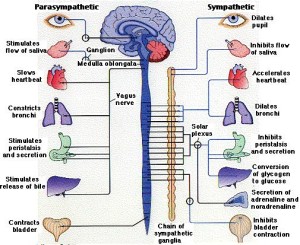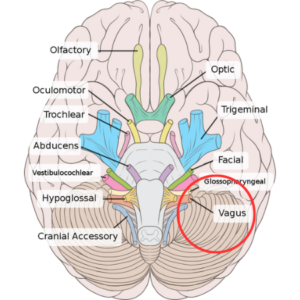 When someone tells you to relax or you try to breathe deeply to calm down from a tense situation you are hoping to stimulate the vagus nerve, which controls much of our ability to chill out.
When someone tells you to relax or you try to breathe deeply to calm down from a tense situation you are hoping to stimulate the vagus nerve, which controls much of our ability to chill out.
It isn’t really under our conscious control, but thousands of years of meditation and yoga have essentially been undertaken to foster a better relationship with the vagus nerve.
The vagus nerve is the 10th cranial nerve (though it is actually two nerves and for the record, there are twelve cranial nerves), used to regulate many body functions including our heart rate, breathing, and digestion.
Vagus is Latin for “wandering”, and is so named for the meandering voyage it takes from the back of the head through the trunk.
The left and right vagus nerves pass down behind the lungs and eventually meeting to form the esophageal plexus.
A plexus is a nerve bundle that acts as a meeting point for a group of nerves before they continue their path, often, as in the case of the vagus nerve, as new nerves.
The anterior and posterior gastric nerves that emanate from the esophageal plexus are made up mostly of the two vagus nerves.
 In this way the vagus nerve reaches the abdomen with a number of branches connecting to the heart, lungs, thorax, stomach, and ears.
In this way the vagus nerve reaches the abdomen with a number of branches connecting to the heart, lungs, thorax, stomach, and ears.
The human nervous system consists of the central nervous system— the brain and the spinal cord, and the peripheral nervous system—all of the nerves that leave to spinal cord to flow out to the rest of the body.
Within the peripheral nervous system is a division called the autonomic nervous system that influences the function of internal organs.
The autonomic system can be further divided into two more systems that work both together and against each other to maintain homeostasis which is the body’s endless search for some measure of equilibrium.
These two systems are the sympathetic nervous system which relates to excitation and our flight or fight response; and the parasympathetic nervous system which stimulates relaxation to balance the excitation of the sympathetic system.
The vagus nerve is the main component of the parasympathetic nervous system, sending a assortment of signals throughout the body, while also transferring signals back to the brain.
As the main component of the parasympathetic nervous system stimulation of the vagus nerve relaxes over-stimulated organs.
***
